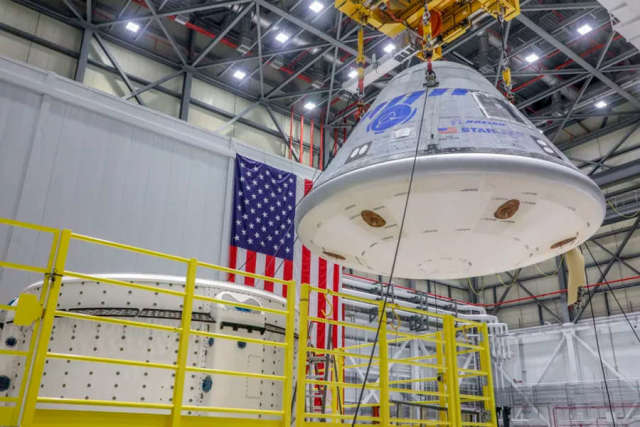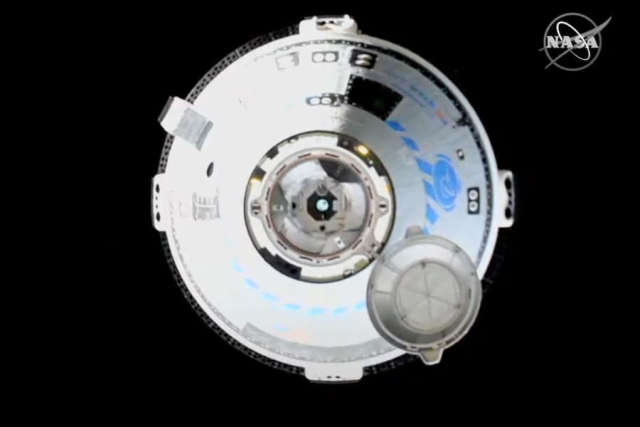The Starliner spacecraft docked to the ISS during a test flight
Boeing has completed a long series of failures related to the development of the Starliner ship. He was able to reach the ISS in unmanned mode, despite a number of emergency situations in flight and failures during previous attempts. Now, if the landing goes well, the first people will be able to go on it to the space station at the end of 2022.
Boeing's Starliner spacecraft docked with the International Space Station during an OFT-2 test flight. The docking was broadcast on the company's YouTube channel.
The ship took off from Cape Canaveral on an Atlas-V rocket with a Centaur upper stage on May 19, its journey took a little more than a day. During the flight, an emergency situation arose - 2 engines out of 12 turned off ahead of time, but the remaining ones took over their function. The docking did not happen immediately: initially, the Starliner made several maneuvers, approaching the station and flying back to demonstrate its capabilities.
At 03:28 Moscow Time, while over the southern Indian Ocean, the ship docked to the American Harmony module. "Starliner looks great against the background of the station," astronaut Robert Hines reported from the ISS.
The docking was completed an hour later than planned.
After the reboot, the ship joined the station without any problems.
"The last few hours have been difficult, when we watched the ship, which barely reaches the ISS," said NASA Deputy Administrator for Space Operations Kathy Luders after docking. "This is a really important demonstration mission, especially valuable for us during it was to get data and learn something on each of them steps, completing all stages of the test."

Image Source: Starliner
The test flight took place in unmanned mode with 250 kilograms of cargo, including the ship delivered to the ISS several water-absorbing gaskets designed to solve the problem of water leakage into the helmet from American spacesuits. If the Starliner successfully unlocks and lands, and American engineers solve the problem with the engines shutting down, then a test flight with four astronauts on board may take place as early as the end of 2022.
The development of the Starliner began more than ten years ago, even before the completion of the Space Shuttle program. The first grant from NASA to create a means of delivery to the ISS was received in 2010, at the same time Boeing demonstrated the first sketches. It was believed that the company's vast experience gained during the development of Apollo, the shuttles and the ISS would allow creating a new ship quickly and without problems. According to initial statements, the Starliner could be ready by 2014.
Then 2015 was called as the deadline, but the assembly was able to begin only in 2016. The new deadline was 2017, then 2018, and finally 2019. At the same time, the ship can hardly be called innovative: in its basic design, it is similar to the Apollo command module, but slightly larger than it. In total, it can accommodate 7 people, the duration of the flight in the state docked to the ISS reaches six months, autonomous - 60 hours. The Starliner is not designed for flights beyond low Earth orbit, and it has no unique capabilities, with the exception, perhaps, of a large passenger capacity.
However, the first test flight of the OFT, which took place in December 2019, ended in failure. Due to a timer failure, the Starliner did not start the maneuver of re-entry into orbit on time, which led to unplanned operation of small maneuvering engines and their fuel consumption. As a result, the docking with the ISS was canceled and the ship landed at the landfill in New Mexico.
The next test, OFT-2, was scheduled for August 2021, but this time the Starliner could not even break away from the launch table. A few hours before takeoff, 13 of the 24 valves regulating the supply of oxidizer did not pass the opening-closing test. The ship was returned to the engineers for inspections, during which it turned out that due to the humid air in the area of the cosmodrome, the oxidizer (diazote tetraoxide) partially turned into nitric acid, which led to corrosion of the material. Fixing this problem took about six months.
Starliner became the second American private passenger ship after SpaceX's Crew Dragon. The contracts for their creation were concluded at the same time, in 2014.
"This corresponded to a new concept in the US manned cosmonautics adopted in the 2010s - to duplicate manufacturers of key space equipment and order not the products themselves, but services, for example, for the delivery of cargo or astronauts to the ISS. Initially, NASA trusted Boeing Corporation more, which has extensive experience in the development of aerospace technology. This affected even the cost of contracts, Boeing received $4.2 billion, and SpaceX - only $2.6 billion," he told the newspaper.Ru" Alexander Khokhlov, an expert in the field of cosmonautics, a member of the North-Western Organization of the Federation of Cosmonautics of the Russian Federation.
The Crew Dragon test flight took place in 2019, the same year as the Starliner, but it passed without serious problems.
"The test flights showed that Boeing specialists made a more crude ship without conducting full testing of systems and software, which is why it did not reach the ISS. It took 2.5 years to correct the errors," the expert added.
At the same time, Khokhlov believes that the initial assessment of Boeing as a more experienced company was erroneous. She had no direct experience of building capsule-type ships, while SpaceX had been operating the Dragon cargo ship, also a capsule, for several years.
Vasily Zaitsev

